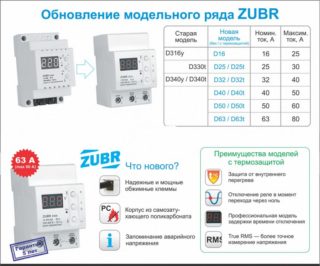In modern housing, great importance is attached to the protection of the electrical network from strong overvoltages. For this, network stabilizers are used to smooth out sharp fluctuations, but differ in a number of disadvantages. It is much more profitable to use inexpensive and compact 220V voltage relays for the home, which provide reliable protection for household networks. These devices, abbreviated as RKN, are mounted in a switchboard and do not require significant space within the apartment.
- Principle of operation and functionality
- Classification and types
- Advantages and disadvantages of plug-in products
- Which type is preferable
- Features of the installation of ILV
- Setting modes
- Description of popular models
- Devices under the Zubr brand
- RN series
- UZM series
- Devices from the company "DigiTOP"
- Devices of the ABB brand
Principle of operation and functionality
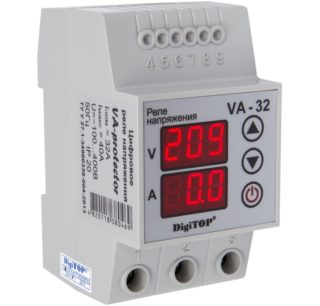
The principle of operation of the device, known to most amateurs under the name of the 220V voltage limiter, can be understood after familiarizing yourself with its device. The structure includes the following units:
- electronic control module, adjustable for the lower and upper limits;
- driver of the control signal;
- an electromagnetic relay that turns off the device when the setting is exceeded.
When the mains voltage reaches one of the limit levels, the electronics generates a control signal that supplies power to the monitoring relay. It works and de-energizes the line, protecting household appliances connected to the outlets.

The functionality of such products in comparison with the same stabilizer is significantly expanded:
- Two thresholds can be set (upper and lower).
- The devices have LED indicators built into the front panel and providing control of the presence of voltage at the input and output.
- A liquid crystal display is provided, on which the values of the main parameters of the mains supply are recorded.
The listed possibilities greatly facilitate the operation of protective equipment installed in an apartment or in a country house.
Classification and types

The known types of ILV differ in the type of power used in the dwelling, according to which they are single-phase or three-phase. Relays for supply voltage 220V are installed in urban housing, and their three-phase counterparts are used in offices or enterprises. They are often found in private houses, to which a branch from the 380 Volt line (three-phase power supply) is connected.
According to the method of connection to the serviced line, the well-known models of 220V mains voltage control relays for the home are divided into the following types:
- adapters plugged into a regular outlet;
- extension cords with several sockets (from 1 to 6);
- devices mounted in a panel on a DIN rail.
The first two positions are transition devices that provide protection for individual household consumers. This is how they fundamentally differ from ILVs installed in the control cabinet. Whole groups of electrical appliances can be connected to them.
Advantages and disadvantages of plug-in products
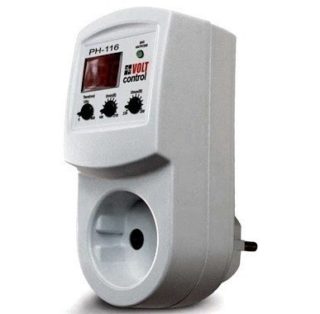
Before purchasing a voltage monitoring relay for an outlet, it is important to evaluate its merits, which justify the purchase.
- Ease of installation, compactness and mobility (the ability to turn on anywhere);
- relatively low cost;
- attractive design that does not interfere with the interiors of the premises;
- universality: admissibility of use for the protection of an individual consumer or several loads at once.
The design of adapters and extension cords is well developed.Their appearance meets the most demanding requirements and does not introduce visible disturbances to the interiors of the rooms. The disadvantages include the lack of a number of options available for devices that are installed on a DIN rail.
Which type is preferable
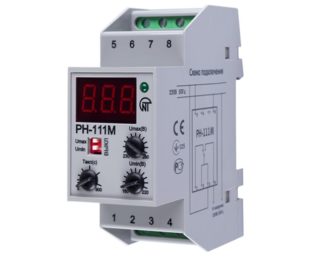
If the user is concerned about the safety of an expensive refrigerator model, for example, and all other devices are already protected by a stabilizer, it is more convenient to purchase a sample of the "socket-plug" type.
In this case, the installation of a general automatic device would be unnecessary, as it would lead to unnecessary costs. This option is more suitable for residents of city apartments who do not want to spend money on installing the ILV in the switchboard (for this you will have to invite an electrician).
Regardless of the operating conditions of the monitoring relay, it should be understood that installing several devices in the socket will cost more than one in the dashboard.
When there is no stabilizer in the house, and its owner wants to reliably protect the kitchen and room equipment, it is wiser to choose a device mounted on a DIN rail. When installing several relays - one for each protected line - the possibility of damage to expensive equipment is completely excluded. They are optimal for a private house, where they can control a three-phase network.
Features of the installation of ILV
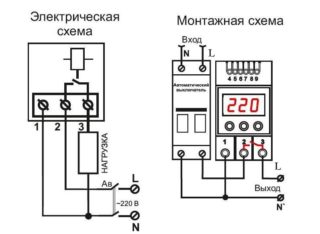
The general procedure for mounting a relay in an electrical cabinet is determined by the requirements of current standards (PUE, in particular). Each specific ILV model can be installed in accordance with its functions. The following options for installing the relay in the wiring line are possible:
- placement immediately after the electric meter (this method is considered classic);
- connection together with an RCD and a linear automaton, which expands the functionality of the device;
- installation up to an electric meter, allowing the metering device itself to be protected against overvoltages.
The latter option is possible only after obtaining permission from the representatives of Energosbyt.
Depending on the method of connection to the load, various ILV samples are installed either according to the scheme of direct connection to the load, or through the power contacts of the magnetic starter. The second option significantly expands the capabilities of the device in terms of load current.
Setting modes
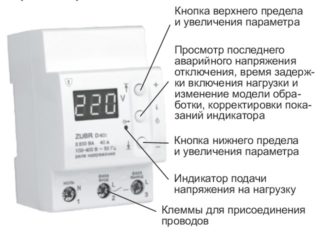
The ILV threshold values are set using several potentiometers on a graduated scale placed along with the knobs on the front panel.
In some examples, buttons are used to set the response limits.
The step with which the lower and upper boundaries are set for most ILV samples is one Volt. The correctness of setting the desired parameter is controlled by the indicator board on the front panel of the device.
On some models, another regulator is provided that sets the time for the device to return to its original state, the moment when the load is reconnected to the power circuit. It can be set in a wide range of values from a few seconds to 10 minutes.
Description of popular models
Wiring diagrams and settings for most models offered by domestic manufacturers have much in common, they can differ only in details.
Devices under the Zubr brand
- simplified internal connection;
- together with an RCD and a circuit breaker.
In the first case, the load is connected directly to the output of the device, and in the second, the control circuit is closed through the RCD and AB. Such inclusion of the Bison allows protecting the line not only from voltage surges, but also from current leaks.
The devices have various versions with different rated currents (25-63 Amperes). The upper threshold of operation is from 220 to 280 with a step of 1 Volt, and its lower value is from 120 to 210 Volts. The re-inclusion time in the line varies from 3 to 600 sec. The adjustment step is 3 seconds.
RN series
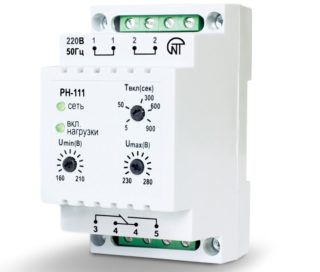
The RN-113 model is switched on after the electric meter and allows manual setting of the values of the lower and upper response thresholds indicated on the display built into the front panel. The device is capable of automatically connecting the power supply network when its parameters are restored after strong voltage surges.
For normal operation of devices of this series, a power reserve of at least 20% is required.
In addition to the limit values, the indicator displays the network parameters when the consumer is disconnected, as well as the time remaining before switching on. The rated current is 32 Amperes; if desired, it can be increased by installing a magnetic starter.
UZM series
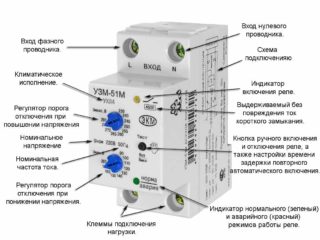
The UZM-51M device, installed immediately after the electric meter, is designed for a rated current of up to 63 Amperes and takes 2 modules at once on a DIN-rail. Its standard width is 35 mm. The maximum set point for the upper voltage limit is 290 Volts. The lower overvoltage trip threshold is 100 Volts.
The reclosing time, manually set by the user, can take two fixed values - 10 seconds and 6 minutes. Devices of the UZM series can be installed in networks with any grounding system: TN-C, TN-S or TN-C-S.
Devices from the company "DigiTOP"
RKN series V-protektor are used only for protection against voltage surges. They are designed for rated currents from 16 to 63 Amperes. The upper response threshold is set in the range from 210 to 270, and the lower one - from 120 to 200 Volts. The automatic recovery time of the on state is from 5 to 600 sec. The three-phase V-protektor 38 device is designed for a maximum current of no more than 10 Amperes.
Devices of the ABB brand
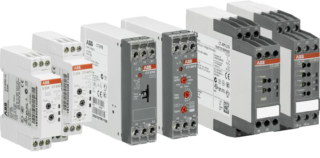
The popular ABB CM series relays allow you to adjust the operation threshold in a wide range of values (from 24 to 240 Volts in single-phase circuits and from 320 to 430 Volts in three-phase circuits). Most models have a recovery time of 1 to 30 seconds.

